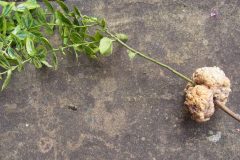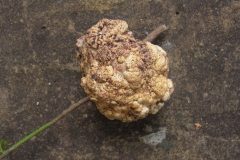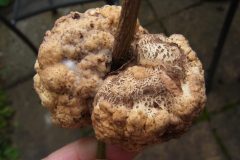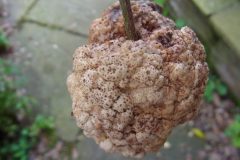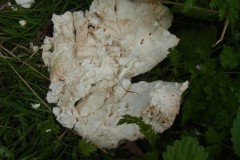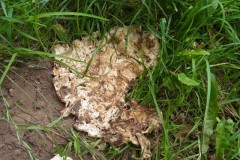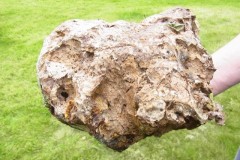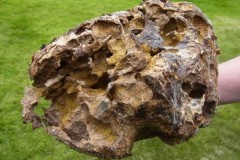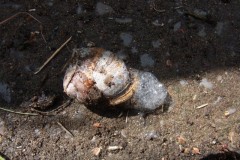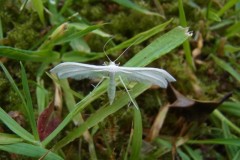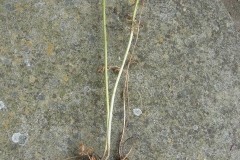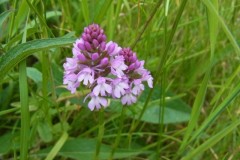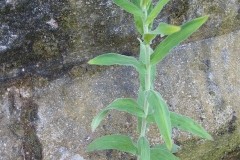In August I found an abnormal growth on a stem of Euonymus fortunei, which I was pruning close to the ground whilst gardening in North Yorkshire. After reading about Crown Galls on Silver Birches on Nora’s blog I googled Crown Galls on Euonymus fortunei and found a description on a pest and disease site that perfectly described the growth. The description was “The galls are white to greenish at first and firm like a cauliflower but become hard and brown with age.” The site identified the Crown Gall as Rhizobium radiobacter (formerly Agrobacterium tumefaciens).
I also checked on the RHS website, which states that “Crown gall is a disease caused by the bacterium Rhizobium radiobacter (synonym Agrobacterium tumefaciens), which enters the plant through wounds in roots or stems and stimulates the plant tissues to grow in a disorganised way, producing swollen galls. Crown gall affects many plants, both woody and herbaceous. Galls are present all year.”
The website further describes the biology as follows:
“The crown gall pathogen Rhizobium radiobacter inhabits the soil where it can survive for long periods. Not all strains of this bacterium are pathogenic (capable of causing disease) and there are several different pathogenic strains with differing host ranges.
The bacteria enter stems or roots through wounds. The bacterial DNA combines with the DNA of the plant host cell where it ‘transforms’ the cell, causing it to become tumour-forming (galls) and also to produce specific new materials on which the bacteria feed. As the gall grows, the plant tissues become disorganised and normal transport processes are disrupted.
In herbaceous plants, the gall rots and the bacterial cells return to the soil. On woody plants, the galls are woody and perennial and do not rot away.”
After Nora consulted Margaret Redfern, author of many books on galls, and Brian Spooner, a member of The British Plant Gall Society, Brian replied. “I am sure you and Margaret are right, the Euonymus galls are indeed almost certainly bacterial in origin, and will be due to what has long been known as Agrobacterium tumefaciens, the cause of ‘crown gall’.. This is now referred to Rhizobium radiobacter. This bacterium has an enormous host range, and an enormous literature too as it is so prevalent and economically important. The recorded hosts do include Euonymus fortunei. It is now understood that only those ‘strains’ of the bacterium which have a gall-inducing plastid are able to cause galls. Rhizobium radiobacter, which was considered distinct as it was not a galler, is actually the same species and evidently the correct name to use. The strains with the plastid were previously known as A. tumefaciens.“
The Euonymus was growing close to a small path in our garden and it is quite possible that the stem was damaged by being caught or trodden on as we walked past causing the stem to produce this growth.
A time for Giant Puffballs (Calvatia gigantea)
We were walking with David along the River Idle at Notts Idle Valley Reserve on 12th August when we came across this Giant Puffball and close by a second one that looked as though it had been kicked open (photos 2 and 3).
Then on the 17th when we were up in N Yorkshire working in our garden there I came across this specimen at the back of our wooden compost bins. At first I wondered if it was a wasps‘ nest and gingerly gave it a kick. However as nothing happened John bravely fetched it out and we were able to confirm that it was a Giant Puffball. It was clearly past it’s best as you can see in the last photo and was developing quite an odour.
Follow up roughly a fortnight after the meeting on June 6th 2023 in Finningley Churchyard
A fortnight can indeed make a difference, working in the churchyard yesterday (19th June) Lady’s Bedstraw had come into flower and I saw my first Harebell and Common Knapweed flowers of the season. I also found Hoary Willowherb, Epilobium parviflorum, and once again, growing at the foot of the church’s north wall and behind the church tower, two Pyramidal Orchids, Anacamptis pyramidalis, are in flower. Curlews were heard calling again from the airfield (one positive from the closure of Robin Hood Airport) and a Song Thrush was spotted singing in the top of one of our Hollies.
Here are some photos I took when working in the churchyard in sunny conditions.
I was clearing out the drainage channel around the church when I discovered this snail that appeared to be creating foam. I may have caught it and wondered if it was some kind of defence mechanism. I wondered if any of the Nats had come across this behaviour.
White Plume moth, Pteroforus pentadactyla
I was pulling some of the vegetation out that was growing at the foot of the church walls and discovered why Bulbous Buttercups are so named.
Here are the Pyramidal Orchids, Anacamptis pyramidalis. I have recorded Pyramidal Orchids twice before in 2016 and 2021, in each instance growing in totally different parts of the churchyard!
Hoary Willowherb, Epilobium parviflorum
Tricia
